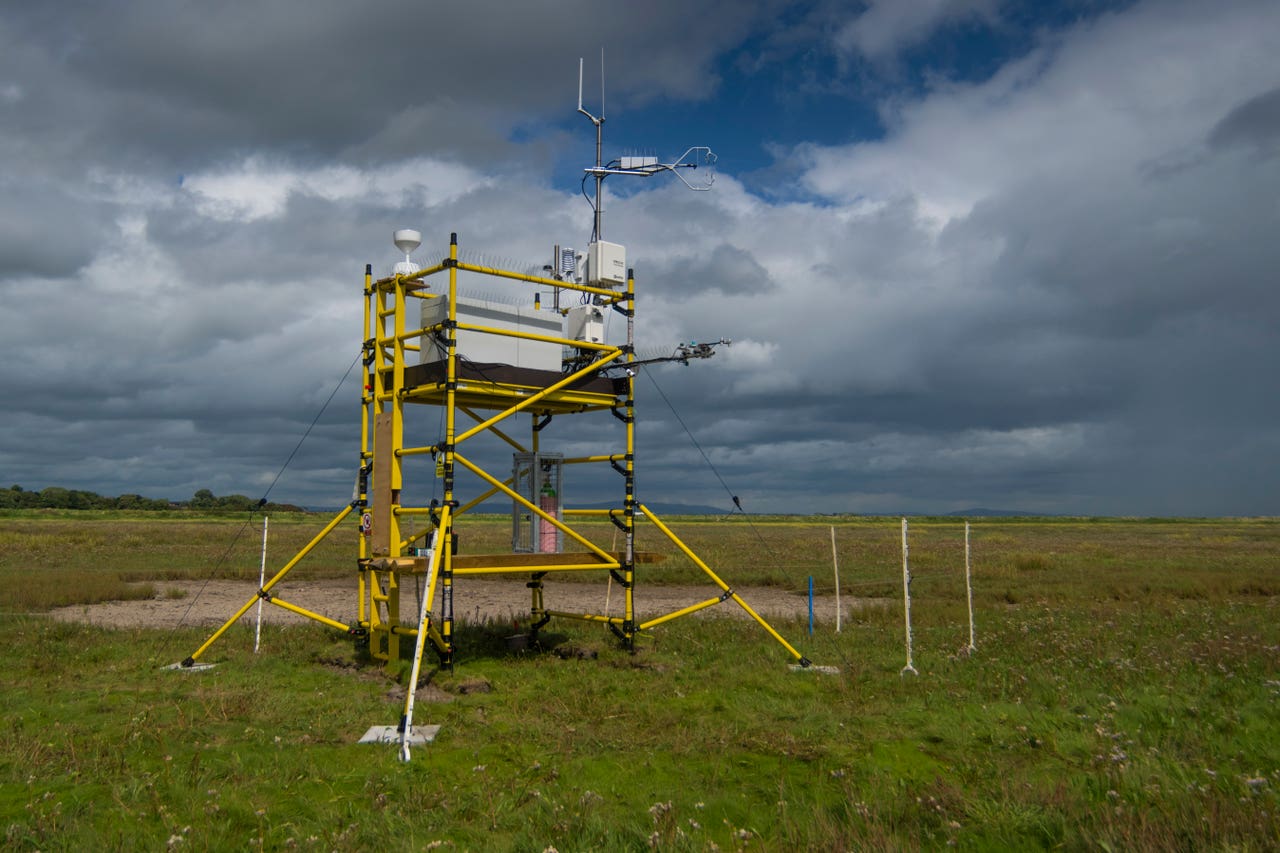
A report from conservation charity WWF in partnership with insurance giant Aviva highlights the important role of saltmarshes around the UK’s coasts in tackling climate change and protecting coastal communities.
The report reveals findings from a solar-powered “carbon flux tower”, funded by Aviva, which measures the exchange of key greenhouse gas carbon dioxide between the air and the saltmarsh on the Ribble Estuary, Lancashire.
It is a technique already used to monitor carbon capture and releases in other vital habitats such as woodlands and peatlands, but has now been adapted and applied to saltmarsh, with the Ribble Estuary producing the first results from a new network of towers.
>> In Other News: Trump Administration Terminates Award for Kentucky Carbon Capture Project

The carbon flux tower used to measure carbon dioxide levels on the Ribble Estuary (Andrew Parkinson/WWF UK/PA)
The data show the habitat is a significant “sink” or store of carbon dioxide, and while there are seasonal fluctuations in storage and release of the gas, the amount absorbed during the spring and summer outweighs what is released during the autumn and winter months.
WWF and Aviva are calling for saltmarshes to be included in the UK’s “greenhouse gas inventory” – the official record of the country’s emissions and removals which is used to track progress towards reducing climate pollution to zero overall, known as net zero.
The two organisations argue that including saltmarshes would improve national reporting and help unlock funding and policy supporting the habitat’s protection and restoration.
Experts warn that 85% of the UK’s saltmarshes, which provide wildlife habitat, carbon capture and natural flood management through slowing the movement of seawater inland, have been lost since the mid 19th century.
The remaining habitat plays a crucial role in shielding coasts from rising seas and storm surges, helping protect assets worth more than £200 billion in England and Wales, the report said.
But with climate change driving rising sea levels, the new report, produced in collaboration with the UK Centre for Ecology and Hydrology and the RSPB, assesses how the country’s remaining marshes are faring as waters rise.
To find out if saltmarshes were able to maintain their height above sea level, the conservationists set up a network of surface elevation tables, which measure how marsh height changes over time, across six UK saltmarshes.
The assessment found that generally saltmarshes were gaining height, although the results varied by region.

Saltmarshes are important habitats for wildlife, as well as carbon stores and protection for coastal communities (Rose Summers/WWF-UK/PA)
Marshes in areas such as Chichester and The Wash in East Anglia appear to be expanding, while those in North Norfolk and the Ribble are showing signs of struggling in the face of rising sea levels, the report said.
Tom Brook, ocean conservation specialist at WWF, said: "The results are in, and mud matters. Saltmarshes are powerful natural allies in the fight against climate change – storing carbon, protecting our coasts and supporting rich biodiversity.
"As extreme weather and rising sea levels put more people and places at risk, the case for protecting and restoring these habitats has never been stronger.
"This research adds to a growing body of evidence showing that saltmarshes are not just ecologically important but essential to building a resilient, net zero future."
Subscribe to the newsletter
Daily decarbonization data and news delivered to your inbox
Follow the money flow of climate, technology, and energy investments to uncover new opportunities and jobs.
Latest issues
-
Inside the $26B Hydrogen Bet Starting Now
Inside This Issue 💧 Five US Green Hydrogen Projects Begin 2025 Shift to Cleaner Energy 🪨 Conestoga Energy Submits Class VI Carbon Capture & Sequestration Permit Application to EPA Region 7 ⚡ P...
-
$800M Baton Rouge BECCS Plant Marks Turning Point for U.S. Carbon Capture
Inside This Issue 🏭 $800M Baton Rouge BECCS Plant Marks Turning Point for U.S. Carbon Capture 💸 CUR8 Raises Seed Round Led by Airbus Ventures 🌾 New Belgium, Root Shoot Malting, and Olander Farms S...
-
How States Are Rewriting the DAC Playbook
Inside This Issue 🌎 States Drive Direct Air Capture Forward as Markets Mature 🏭 Aircapture Launches First Commercial DAC Facility in Japan ⚡ Transition Industries Awards Techint E&C and Siemen...
Company Announcements
-
Ebb Carbon’s Project Macoma Begins Operations in Port Angeles
PORT ANGELES, Wash.--(BUSINESS WIRE)--Ebb Carbon today announced that Project Macoma has begun operations at the Port of Port Angeles. The temporary pilot builds on two years of demonstrations at P...
-
TCMA Signs MOU with Saskatchewan to Advance CCUS Collaboration
Thailand: The Thai Cement Manufacturers Association (TCMA) has signed a memorandum of understanding (MOU) with the government of Saskatchewan in Canada, represented by the Ministry of Trade and Exp...
-
OXCCU Raises $28 Million to Turn Waste Carbon into Low-Cost Sustainable Aviation Fuel
UK-based climate tech startup OXCCU announced today that it has raised £20.75 million (USD$28 million) in a new Series B funding round, with proceeds from the financing aimed at supporting the scal...
-
Conestoga Energy Submits Class VI Carbon Capture & Sequestration Permit Application to EPA Region 7
Milestone submission positions company to lead regional CCUS expansion while unlocking commercial carbon storage opportunities LIBERAL, Kan.--(BUSINESS WIRE)-- Conestoga Energy (“Conestoga” or the...